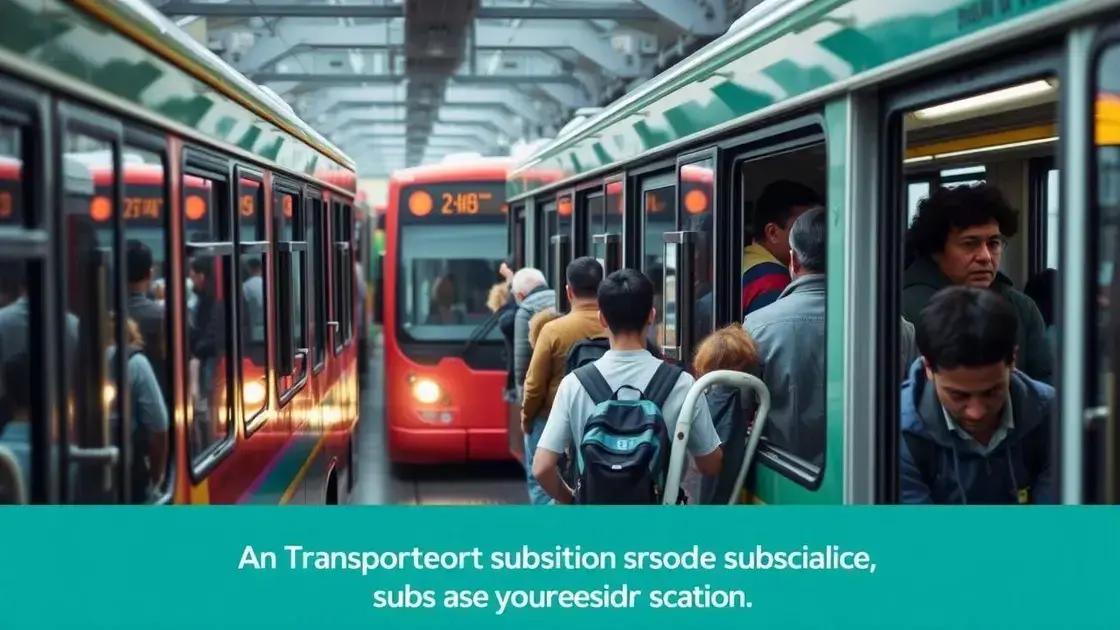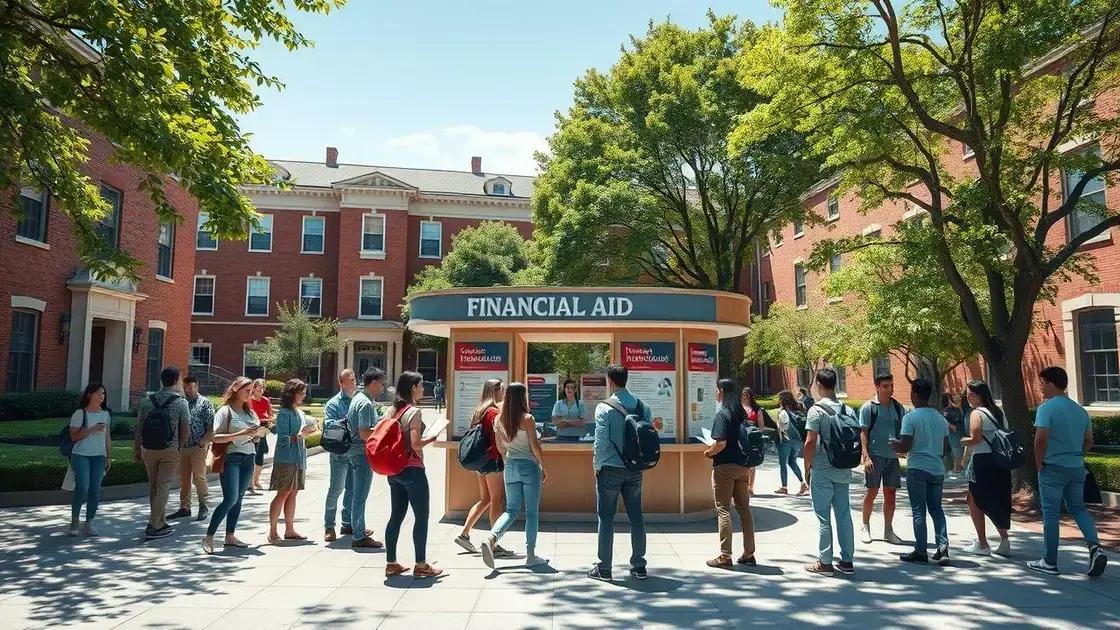Transportation subsidies: a key to affordable commuting

Anúncios
Transportation subsidies are financial aids designed to lower commuting costs, enhance public transit usage, and promote equitable access to transportation, addressing key challenges like funding and public awareness.
Transportation subsidies play a crucial role in making commuting accessible and affordable for everyone. Have you ever wondered how these programs truly impact your daily travel costs? Let’s dive into the world of transportation subsidies and explore their significance.
Anúncios
Understanding transportation subsidies
Understanding transportation subsidies is essential for grasping how they can help individuals save money on their daily commutes. These programs are designed to reduce transportation costs for citizens, making mobility more affordable.
What are transportation subsidies?
Transportation subsidies are financial aids provided by the government or organizations to lower the costs associated with using various transport modes. They can support public transit systems, encourage carpooling, or even assist with bike-sharing programs. By focusing on these options, we create more accessible commuting solutions.
Key benefits of transportation subsidies
- Lower commuting expenses reduce the financial burden on households.
- Encouragement of public transit use leads to less traffic congestion.
- Promotion of environmentally friendly transport options supports sustainability.
- Increased access to jobs, schools, and services enhances social equity.
Transportation subsidies also contribute to improving public health by reducing air pollution and encouraging active commuting methods, like biking or walking to the nearest transit point. This multifaceted approach aids not only individual commuters but also local communities.
Anúncios
When properly funded and managed, these subsidies can transform the way we think about travel. They enable people to choose more sustainable options without worrying about high costs. With a clearer understanding of how these subsidies work, individuals can take advantage of available programs to improve their commuting experience.
Common types of transportation subsidies
Governments often implement various types of transportation subsidies to address specific needs:
- Direct fare reductions for public transit users.
- Tax credits for individuals who use rideshare services.
- Subsidized carpooling programs that reward shared commuting.
- Funding for improving bike lanes and walking paths.
These initiatives illustrate the commitment to creating a transportation system that serves everyone fairly and efficiently. As we delve deeper into the impact of transportation subsidies, we can appreciate how they reshape our daily lives.
Benefits of transportation subsidies for commuters
The benefits of transportation subsidies are significant for commuters, providing financial relief and encouraging sustainable travel options. Many people struggle with the high costs associated with daily commuting, and these subsidies can make a difference.
Financial savings
One of the most immediate benefits is the reduction in commuting expenses. By lowering the cost of bus or train fares, subsidies help individuals save money that can be used for other essential needs. This financial support makes commuting feasible for more people.
Encouragement for public transit use
- More riders contribute to less traffic congestion in urban areas.
- Increased usage of public transport aids in promoting environmentally friendly practices.
- Challenges like air pollution decline as more people opt for public transit.
- Improved public transit systems create more reliable options for daily commutes.
Moreover, transportation subsidies foster a sense of community. When individuals use public transport, they are likely to encounter others in their neighborhood, creating an environment that emphasizes shared experiences. This can lead to better social interactions and a greater sense of belonging.
Subsidies also provide access to more job opportunities. By making it easier to reach various work locations, individuals can apply for positions that may have previously seemed out of reach due to transportation limitations. This means more people can find employment, further enhancing local economies.
Improved health and environment
By encouraging the use of public transit and reducing reliance on personal vehicles, transportation subsidies contribute to improved air quality. Fewer cars on the road lead to less air pollution, benefiting everyone in the community. Additionally, using public transportation encourages more walking or biking to transit stations, promoting healthier lifestyles.
In summary, the benefits of transportation subsidies for commuters include financial savings, increased public transit use, better job access, and improved health and environmental outcomes. These advantages illustrate how such subsidies play a vital role in enhancing the overall commuting experience.
How transportation subsidies affect public transit

Transportation subsidies have a significant impact on public transit, leading to various improvements that benefit both the systems and the users. By providing financial support, these subsidies encourage the expansion and enhancement of transit services.
Increased ridership
With lower fares thanks to transportation subsidies, more people are likely to use public transit. This increase in ridership can lead to more funding for transit systems, allowing for better services and more frequent schedules. As more individuals choose public transit, it helps reduce traffic congestion on the roads.
Enhanced service quality
- Subsidies allow transit agencies to invest in vehicle maintenance and upgrades.
- Increased funding enables expansion of routes and schedules.
- Service reliability improves, making public transport a more viable option for daily commutes.
- Subsidies can also fund new technologies, such as real-time tracking apps for users.
Moreover, as the quality of public transit services improves, the public perception of these systems changes. Commuters become more likely to view public transportation as a reliable and efficient option, which further boosts usage.
Transportation subsidies also play a crucial role in addressing social equity. By providing affordable transit options, people from low-income backgrounds gain access to essential services such as jobs, healthcare, and education. This accessibility can lead to improved economic opportunities for many individuals.
Environmental benefits
With increased ridership comes substantial environmental benefits. Transportation subsidies help reduce the number of single-occupancy vehicles on the roads, leading to decreased greenhouse gas emissions. This shift contributes to cleaner air and a healthier environment.
Through these various channels, transportation subsidies create a positive cycle where improved public transit encourages greater use, leading to better services and a more sustainable urban environment. Understanding this relationship is key to appreciating the role of subsidies in fostering efficient and effective public transit systems.
Innovative models of transportation subsidies
Innovative models of transportation subsidies are transforming the way we think about public transit. By exploring creative approaches, cities can address issues like traffic congestion and environmental impacts while promoting accessibility.
Mobility as a Service (MaaS)
One promising model is Mobility as a Service (MaaS). This concept combines various transportation options, such as public transit, ride-sharing, and bikes, into a unified service. It allows users to plan and pay for their entire journey through a single app. Such systems make commuting easier and more flexible, promoting the use of public transit.
Subsidy integration with technology
- Mobile payment systems streamline fare collection.
- Real-time tracking apps enhance user experience.
- Dynamic pricing can adjust fares based on demand, increasing efficiency.
- Data-driven approaches help optimize routes and services.
Integrating technology into subsidy programs enhances convenience and encourages more people to use public transit. With these advancements, riders can enjoy a smoother commuting experience while transit agencies can respond more effectively to demand.
Another innovative approach includes offering subsidies based on individual circumstances. For instance, providing extra financial support for low-income families or students increases accessibility and reduces barriers to transit use. Such targeted subsidies ensure that those who need assistance the most receive it effectively.
Partnerships with private companies
Collaboration between public transit agencies and private companies represents another model. For example, transit agencies can partner with ride-sharing apps to provide subsidized rides for first and last-mile connectivity. This approach helps connect people to public transit options, increasing ridership and reducing reliance on personal vehicles.
By exploring these innovative models, cities can create more sustainable and efficient transportation systems. The future of transportation subsidies lies in these creative solutions, ultimately aiming to make commuting easier and more environmentally friendly.
Challenges in implementing transportation subsidies
Implementing transportation subsidies presents several challenges that can hinder their effectiveness. Understanding these obstacles is crucial for creating successful programs that truly benefit commuters.
Funding and budget constraints
One of the main challenges is securing adequate funding. Governments often operate under strict budget limitations, which can restrict the amount allocated for subsidies. This can lead to inadequate programs that do not meet the needs of all commuters.
Equity issues
- Subsidies must reach those who need them most, such as low-income individuals.
- Geographic disparities can result in some areas receiving more resources than others.
- Potential stigma associated with receiving subsidies can deter eligible individuals from applying.
Furthermore, ensuring equitable access to subsidies is essential. Without careful planning, some groups might benefit disproportionately, leaving others without the support they require. This can create feelings of frustration and inequity in communities.
Public awareness and education
Many people remain unaware of available transportation subsidies or how to access them. Effective outreach and education programs are essential in raising awareness about these options. Without them, the subsidies designed to assist commuters may go underutilized.
It’s also important to consider the complexities of the application process. If the process is too complicated or time-consuming, potential beneficiaries may opt out, thus negating the intended impact of the subsidies.
Political and administrative hurdles
Transportation subsidies also face political challenges, as priorities can shift with changing administrations. Different political leaders might have varying views on transportation policies, affecting the stability and continuity of subsidy programs. Additionally, administrative inefficiencies can slow down the implementation of these programs, leading to further challenges in delivering support to those who need it.
Addressing these obstacles is critical for the success of transportation subsidies. Only by overcoming these challenges can we ensure that subsidies are effectively implemented and benefit the commuters they are designed to support.
In conclusion, understanding the intricacies of transportation subsidies reveals their critical role in enhancing public transit. While they offer many benefits, such as increased ridership and improved accessibility, challenges associated with funding, equity, and public awareness must be addressed. By leveraging innovative models and overcoming these hurdles, we can create more efficient and sustainable transportation systems. Collaboration among government agencies, community members, and private organizations is essential to ensure these subsidies reach those who need them most. Ultimately, effective transportation subsidies can lead to improved mobility, healthier communities, and a greener environment.
FAQ – Frequently Asked Questions about Transportation Subsidies
What are transportation subsidies?
Transportation subsidies are financial aids provided to reduce the costs of public transit, making commuting more affordable for individuals.
How do transportation subsidies benefit commuters?
They lower commuting expenses, increase access to jobs, and promote the use of environmentally friendly transit options.
What challenges do transportation subsidies face?
Challenges include securing adequate funding, ensuring equitable access, and raising public awareness about available programs.
How can innovative models improve transportation subsidies?
Innovative models, like Mobility as a Service (MaaS) and partnerships with private companies, enhance accessibility and efficiency in public transit systems.





